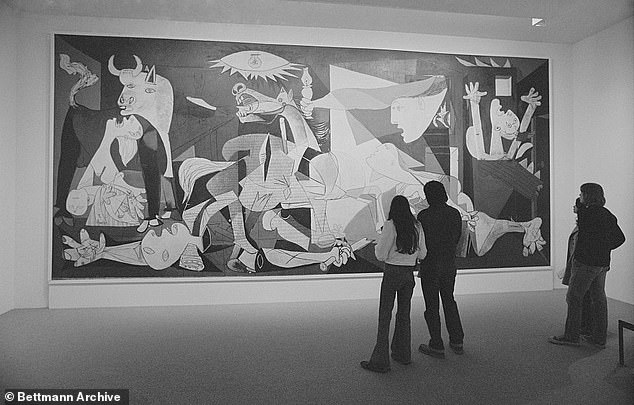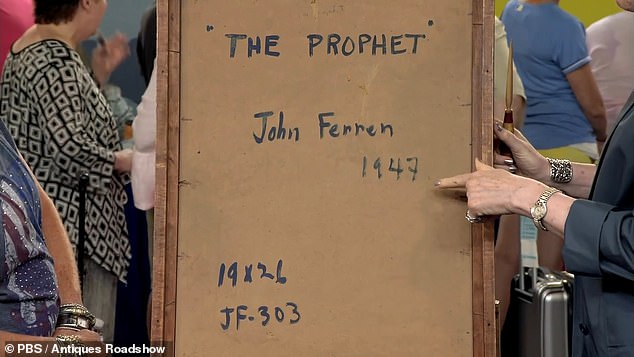Antiques Roadshow guest breaks down in tears at five-figure valuation of artwork she thrifted for just $9.99: ‘My kids say it’s ugly!’
A guest on Antiques Roadshow showed off a painting she snagged for $9.99 and was shocked by how much her abstract piece could fetch if she sold it to a gallery.
The 1947 painting, called “The Prophet,” was by American artist John Ferren, who was born in Oregon in 1905 and first studied art in San Francisco, as appraiser Nan Chisholm noted to the guest.
The guest said she never spends more than $9.99 on art, adding that she was “immediately” drawn to Ferren’s piece when she saw it at the thrift store.
Her children are not so kind to the painting, which she says rests on her mantelpiece and “gives her peace when she looks at it.”
“My kids say it’s ugly,” she told the appraiser.
The guest in the photo cries with joy when she heard that the painting to her right, which she has had for years, could be sold for a five-figure value

The guest and the appraiser, Nan Chisholm, examine Ferren’s 1947 ‘The Prophet’
Chisholm said Ferren became part of the Abstract Expressionism movement early on. He really blossomed as an artist in the 1930s in Paris and Italy, where he studied with the intention of becoming a sculptor.
“But after seeing an exhibition of Henri Matisse’s work in Munich, he decided he would concentrate on becoming a painter,” Chisholm said.
His new ambitions took him down a path where he married the daughter of a Spanish artist, whom he would later divorce in 1938.
Nevertheless, with his new social circle in Paris he had the opportunity to meet great Spanish artists such as Pablo Picasso and Joan Miró, both of whom influenced him greatly.
Ferren even helped Picasso sketch one of his most enduring works, Guernica (1937), a response to the 1937 bombing of the city during the Spanish Civil War.

Spectators view Guernica, executed in 1937 by Spanish-born painter Pablo Picasso at the Museum of Modern Art in New York City
Ferren completed the painting in the guest’s possession about ten years after he returned to the US.
Chisholm first wrote Ferren’s name at the bottom of the painting and then turned the canvas over to reveal the back.
He was delighted with how legibly and clearly all the relevant information was written.
“I want to show everyone that not only does it have the date 1947 on it… but also that the artist’s name is clearly printed so it can be easily read,” Chisholm said.
Also on the back was the size of the painting, 19 inches by 26 inches, and an inventory number of the artist.
‘It’s really great to have all this information here. It’s like a dream come true,” she said.
After reassuring the guest about the various “surface condition issues,” also known as paint blemishes, Chisholm asked the question that is asked to all Antique Roadshow guests.

Chisholm was ecstatic at how legibly and clearly all the relevant information was written on the back of the painting
“Do you have any idea what it might be worth, other than $9.99?”
The guest laughed and said she didn’t know.
After telling the guest that the painting was “basically in good condition,” Chisolm estimated that Ferren’s “The Prophet” could sell to a retail gallery for $15,000 to $20,000.
“Really, $20,000? Wow, that’s a lot,” the guest replied, overcome with emotion and fighting back tears.
“My kids will all be like, ‘Sell it,’ you know, and I’ll just go, ‘No!’
